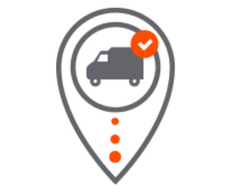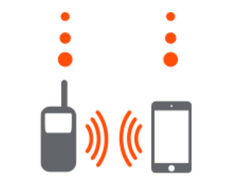Need help?
Assistance
Télécommunications de l’Est, a member of the Iristel family, offers a wide range of products and services. In order to give you the best customer service, we recommend contacting the appropriate department so we can provide you with the right information. Don’t hesitate to contact us with your questions!
Request for service
Contact us
NOMAD Mobile Network
The NOMAD Mobile Network offers excellent technical support. Our experts provide the assistance you need. Clearly, when you opt for the NOMAD Mobile Network, you’ll never be on your own.
Frequently Asked Questions
Answers to commonly asked questions
- All
- Administration
- Business telephone
- Careers
- Cellular Booster
- Miscellaneous
- NOMAD Mobile Network
- Pagers
- Radio communication
- Satellite communications
How to open an account?
You must complete a form to open an account. A credit verification will be done and we’ll provide your credit limit.
Find a branch
1 800 463-9400 option 7
Do you have multiple payment methods?
Yes you may pay by cheque, bank transfer, pre-authorized payment or by credit card.
Find a branch
1 800 463-9400 option 7
Name the differences between VHF (Very High Frequency) and UHF (Ultra High Frequency).
VHF frequency range = 136 MHz to 174 MHz
UHF frequency range = 400 MHz to 420 MHz
Antenna length: the higher the frequency, the shorter the antenna. So a UHF antenna is shorter than a VHF antenna.
The directionality of the waves is different: With VHF, the signal wave tends to propagate horizontally ideal for an application in mountainous terrains. With UHF, the signal wave provides better penetration through objects for urban applications.
Why should a radio antenna be calibrated in the VHF/UHF frequency ranges?
Antenna calibration provides maximum efficiency of radio communication according to the frequency of operation. A calibrated (tuned) antenna ensures maximum RF power is propagated through the air and increases sensitivity to receive an RF signal, providing a better quality of communication and range.
What are the different types of materials or obstacles that can block or attenuate radio signals?
– Metal structures made of steel, iron, sheet metal, etc.
– Well insulated walls incorporating thermofoil
– Concrete buildings
– Mountains
– Some types of LED lights
– Other strong radio waves in the vicinity
What is the difference between a simplex communication and a repeater?
Simplex communication uses the same frequency in transmission and reception of a radio signal between two radios. Communication passes directly from one radio to another with a limited range.
Communication via a repeater uses two different frequencies, one for transmit and one for receive. The signal is intercepted by a repeater antenna installed in a tower, and retransmitted over a greater range.
The two solutions meet different needs that we will be happy to evaluate for you based on your requirements, do not hesitate to contact us for more information.
What is the difference between a CB and a VHF radio?
The CB (Citizen band) radio operates at lower frequencies than a VHF radio. The CB radio communication range can vary depending on the weather, and may be less than the VHF band radios with some exceptions.
CB radios use frequencies that are public and programmed in all CB’s. There is no annual fee to pay, but these frequencies can be listened to by everyone. CB’s cannot be equipped with a repeater which increases the range as is possible with a VHF band radio. CB’s are designed mainly for consumer and non-commercial operations. VHF radio communications are TDE’s specialty, do not hesitate to contact us for more information.
What is the difference between a digital radio and an analog radio?
The differences are related to how the voice is modulated and communicated wirelessly. These two types of modulation have the following advantages:
Digital:
-Provides better clarity of communication thanks to noise reduction algorithms
-Allows more communication to pass at the same time in the same wavelength
-Easily enables advanced applications such as text messages, GPS and data transfers
-Provides longer battery life.
Analog:
-Communication is perceptible despite very low signal levels
-Compatibility with most mobile radios available today.
Hosted – what’s a cloud-based phone system?
“Cloud-based” means that the infrastructure and network delivering the business phone and fax system is located in our multiple, secure data centers across Canada and delivered to your business over the Internet. You don’t need any capital investment and avoid the hassle of installing and managing complex hardware in your office.
Hosted – what is VoIP?
Voice over Internet Protocol (VoIP) allows you to make and receive phone calls over a secure internet connection instead of a standard phone line.
Hosted – how many lines can I purchase?
You can purchase as many lines as you need for your business. We have a number of affordable packages to choose from, and additional lines can also be purchased.
Hosted – can I transfer my existing phone numbers?
Yes, you can transfer (port) your existing toll-free or local phone numbers. Your sales representative will ask you to sign a Letter of Authorization (LOA) to approve the transfer of your numbers from your existing provider. The porting process takes approximately 1 week and is dependent on how quickly your current provider releases the phone numbers.
Hosted – what happens when I lose power or my Internet connection?
Forward calls to your cell phone, so even if your office Internet or power is lost, calls can still be made and received. Programming is required.
Hosted – can I use my existing analog or IP phones?
For analog telephones, it is possible using a converter.
For IP telephones, the model must be supported by Télécommunications de l’Est.
Hosted- what is Basic 911?
With Basic 911 the user’s telephone number and location are not automatically transmitted to the operator. The operator at the answering location verbally obtains the pertinent information that identifies the caller’s need and physical location. The operator then determines the appropriate agency and transfers the caller.
Toshiba – how to change the time?
intercom + #652 + HHMMSS + #
The time must be entered in 24-hour format, example: for 3:25 p.m. (152500).
Toshiba – how to change the date?
intercom + #651 + YYMMDD + #
Toshiba – what is the procedure for forwarding a call to a cell phone?
To activate: intercom + #6011 + 9 + cell phone number + #
To deactivate: intercom + #6051
Ericsson – LG – what is the procedure for forwarding a call to a cell phone?
To activate: pick up the handset + FWD + 9 + cell number + “save”
To deactivate: pick up the handset + FWD + #
Ericsson – LG – how to make a three-way call?
Make a call + conf + make the 2nd call + press Conf twice to join.
Ericsson – LG – how to record corporate greetings?
On the receiving phone, press PGM button + 06 + VSF number + 1 + # to start recording + “save” to end.
What is the territory covered by the pager network?
The territory covered by our network of pagers in Bas-Saint-Laurent and Gaspésie includes the municipalities and regions of Rimouski, Mont-Joli, Matane and all of Gaspésie.
How do you send a message to a pager?
By telephone, by dialing the pager number, at www.tde.ca at the bottom of the page, or by the direct link.
A pager, is it two-way?
No, the equipment only allows you to receive messages.
I have no cell signal, could an amplifier or booster give me some?
A cellular signal booster or booster improves the quality of existing signals from your cordless phones at home, in the office, or inside a vehicle. The signal can be improved by one or two bars on your cell phone. To amplify the signals, it therefore takes a minimum signal to be present first.
Is it possible to rent a SPOT (satellite messaging)?
We do not rent out satellite messaging. However we have several models available for sale.
Is it possible to rent a satellite phone for the hunting or fishing season?
We no longer offer the services of satellite phone rental. However, we can rent you radios equipment that will allow you to talk, for example, between hunters.
I would like to request a quote – call for tenders (RFP). What email can I forward my request to?
You can email us.
How to apply for a job offer?
Simply forward your CV to us via email.
With a radio on the NOMAD Mobile Network, is it possible to go on the internet and Facebook?
No, these functions are not supported.
Is the coverage (performance) of the NOMAD Mobile Network the same with a portable radio as with a mobile radio?
No. There is less of a coverage on a portable radio, largely due to unit power, antenna efficiency, antenna height and signal loss caused by vehicle structure when the radio is used indoors.
Is it possible to use a radio on the NOMAD Mobile Network and on a conventional analogue frequency?
Yes, but not at the same time. When the radio is operating on the NOMAD Mobile Network, it’s not able to connect to an analog frequency at the same time. The user must select, using the menus or button, the mode to be used.
Does a radio on the NOMAD Mobile Network work everywhere?
No, the radio must be in an area that is covered by the NOMAD Mobile Network.
If you cannot find an answer to your question in this Frequently Asked Questions, don’t hesitate to write to us and submit your question directly.
We’ll be happy to make improvements to this section.
Emergencies
Outside regular office hours:
Administration
Accounts receivable (clients):
1-800-463-9400 option 7
Accounts payable (suppliers):
1-800-463-9400 option 7
All other questions
Media enquiries, general information etc.
1-800-463-9400 option 0
Management team
Samer Bishay,
President
1-416-800-9999
sbishay@iristel.com
Vincent Hébert,
General Director
1-800-463-9400 ext. 252
vhebert@iristel.com
Jean Labrie,
RENIR Manager
1-800-463-9400 ext. 204
jlabrie@iristel.com
Eddy Therriault,
Business Telephony Equipment Manager
1-800-463-9400 ext. 242
etherriault@iristel.com
Online support
TeamViewer QuickSupport
Click here to download the remote software support




